Build a Granny Flat to Boost Your Property’s Cash Flow
I’m coaching a client in Steve McKnight’s property training course that lives in the granny-flat-friendly state of New South Wales. She and her partner had the clever idea of converting their existing detached garage into a second dwelling. They carried out as much of the renovation work as possible themselves on a bare bones budget, and then rented the “garage” out at $190 per week.
This simple strategy significantly boosted the overall yield of their existing investment property. Depending on where you live and invest, you might be able to do the same.
What Is A Granny Flat?
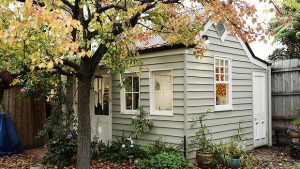 Traditionally, granny flats were just for grannies and grandpas. But due to the explosive growth in Australia’s population, many local and state governments are relaxing granny flat restrictions to meet the demand for affordable rental properties.
Traditionally, granny flats were just for grannies and grandpas. But due to the explosive growth in Australia’s population, many local and state governments are relaxing granny flat restrictions to meet the demand for affordable rental properties.
This presents opportunity for investors like you to maximise your income potential by getting creative and thinking outside the box.
In general, most local governments use specific criteria to classify a structure as a granny flat. A granny flat must:
- Be self-contained, having its own separate access, bathroom, kitchen, bedroom and living area.
- Exist on the same title, with the same ownership, as the main residence.
- Reside on residential property and not on property used for commercial purposes.
- Be limited to only one granny flat per property.
- Sit on a traditional Torrens title, not a strata or community titled property.
But just because you can build a structure to meet these basic qualifications, it doesn’t mean you’ve got an instant income-generating machine at your disposal. Not every state is granny-flat-friendly.
Granny Flat Laws Vary From State to State
If you live in South Australia, Victoria, or anywhere in Queensland except Ipswich, I’ve got bad news for you. Your state’s granny flat laws are very inflexible. You’re welcome to build a second dwelling, but if you rent it out to someone who isn’t a household dependent, then you’re breaking the law. Your primary takeaway from this article should be to lobby your state government to loosen this restriction.
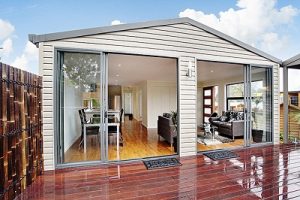 However, if you live in Australian Capital Territory, Northern Territory, New South Wales, Tasmania or Western Australia, congratulations, you actually have some land ownership rights – pardon the sarcasm. You can build an extra dwelling, and then use it to earn rent from virtually anyone who will pay you.
However, if you live in Australian Capital Territory, Northern Territory, New South Wales, Tasmania or Western Australia, congratulations, you actually have some land ownership rights – pardon the sarcasm. You can build an extra dwelling, and then use it to earn rent from virtually anyone who will pay you.
Here’s a breakdown of the basic granny flat requirements for each State:
| Minimum Lot Size | Maximum Dwelling Size | |
| ACT | 500m2 | 90m2 |
| NT | none specified | 50m2 |
| NSW | 450m2 | 60m2 |
| QLD | varies – consult your local council | |
| – Brisbane | none specified | 80 m2 |
| – Ipswich | none specified | 65m2 |
| SA | 600m2 | 60m2 |
| TAS | varies – consult your local council | |
| – Hobart | none specified | 30% of the area of main dwelling |
| VIC | zone dependent | zone dependent |
| WA | none specified | 60m2 |
Be sure to check with your local council for site-specific details related to setback, floor to ceiling heights, energy efficiency and other requirements. You’ll also want to confirm that the above information has not changed since the time of writing. Many of these standards are recent changes, and some are currently under review.
What Type of Granny Flat Should You Build?
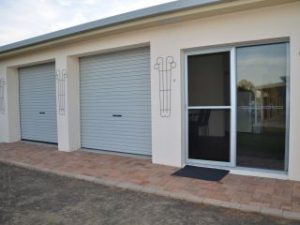 When most people think of a granny flat, they think of a detached dwelling. But there are multiple ways to meet the qualifications of building a self-contained unit.
When most people think of a granny flat, they think of a detached dwelling. But there are multiple ways to meet the qualifications of building a self-contained unit.
1. Convert Your Garage
This is potentially a low cost option, as long as the slab and frame are structurally sound.
You’ll need to have the building certified by a structural engineer to meet compliance requirements.
The down side is that this is the most restrictive option since you’re essentially creating a home from a square box. You’ll also need to sort out a plan B for covered parking.
2. Convert Part of Your Existing Home
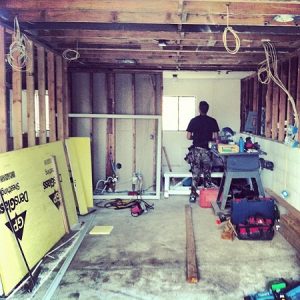 This can also be a low-cost option, because it involves making internal changes to the existing structure.
This can also be a low-cost option, because it involves making internal changes to the existing structure.
Simply adding an unobstructed external entrance and building a small kitchen and laundry could be enough to add a second self-contained dwelling. Bear in mind that some floor plans will be more conducive to this strategy than others.
3. Build an Extension Onto Your Existing Home
 This strategy involves extending the existing structure to create new rooms to form a new, self-contained dwelling.
This strategy involves extending the existing structure to create new rooms to form a new, self-contained dwelling.
Depending on your plans, build costs can blow out quickly, as you may need to make structural changes to the existing home to ensure its integrity.
4. Build a Detached Granny Flat
This is the traditional approach and involves building a new separate dwelling on the same block of land as your main home. This provides a greater feel of independence for the proposed tenant, especially if you build it on a larger block. A detached unit also offers the flexibility of giving the occupant some private garden space.
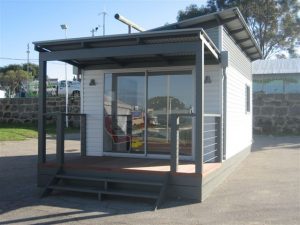 A low cost solution might be to purchase a kit home, which could range in price from $25,000 to $50,000, or more.
A low cost solution might be to purchase a kit home, which could range in price from $25,000 to $50,000, or more.
Keep in mind that this doesn’t include the internal fit-out, such as the kitchen, bathroom, laundry, carpet, electrical, plumbing, drainage, tiles and painting. You’ll also have to sort out the on site labour and construction.
If you want the new dwelling to have a certain look and façade, perhaps to match your existing home, you can have it built from the ground up the old fashioned way. Many quotes float around the $100,000 mark.
5. Build a Dual-Living Dwelling from Scratch
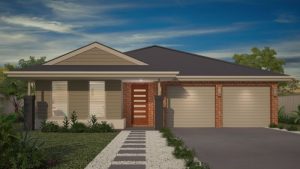 There are some smart builders who takes advantage of the generous New South Wales granny flat legislation by offering dual-living floor plans built from scratch.
There are some smart builders who takes advantage of the generous New South Wales granny flat legislation by offering dual-living floor plans built from scratch.
These dwellings look like a traditional single family home from the street, but actually contain two separate units. One is a three-bedroom and the other is a two-bedroom, both with single bath and single car garages.
Depending on inclusions, you’d be looking at a build cost of about $300,000 or more in today’s market. This doesn’t include the land component. Your accountant would probably also be quite excited by the depreciation benefits.
 Where Should You Start?
Where Should You Start?
1. Consult Your Local Council. Be sure you’re clear on the minimum lot standard, the maximum dwelling size and all other requirements for granny flats in your state and suburb.
2. Assess Rental Demand. Talk to local rental managers and ask for a rental appraisal – not only for your new proposed dwelling, but also for your existing property after the granny flat is complete. You must be confident that your new one-or two-bedroom unit will be easily tenanted. You should expect a rent below other one-or two-bedroom units in the area that may have a more desirable living space. Alternatively, you could consider renting out your secondary dwelling as short-stay accommodation through a platform like Airbnb.
3. Assess Cost And Potential Value. Contact several qualified and trustworthy builders to bid on the construction of your new granny flat. Be sure to factor in all potential costs, including plumbing and sewer, utility connection and council fees. Many builders will be able to provide a turnkey solution.
Next, contact an agent to appraise the value of your entire property after the project is complete. Ask for a valuation that considers both the investor market and the owner-occupier market.
4. Crunch The Numbers. Make sure the deal stacks up. Although your primary concern is cash flow, your secondary consideration should be the impact of adding a granny flat on the overall value of your property. If you’re not sure how to do this, read From 0 to 260+ Properties in 7 Years.
5. Secure Council Approval. Once it’s time to move forward, before commencing construction, you’ll need to secure development approval. In granny-flat-friendly states, you can do this in as quickly as 10 days.
Secure Council Approval. Once it’s time to move forward, before commencing construction, you’ll need to secure development approval. In granny-flat-friendly states, you can do this in as quickly as 10 days.
You’ll need to submit architectural plans, specifications and associated documents with your application. You’ll need a qualified draftsman and possibly an architect and planning consultant, as well.
A word to the wise: Don’t attempt to bypass council approval. If you’re converting a garage or an existing home, you might be tempted to try to fly under the radar and take the easy path. But failure to obtain the necessary approvals prior to construction is an offence in every state and carries heavy fines. If you rent out an unapproved dwelling, you’re exposing yourself to a civil lawsuit and possibly even criminal charges if something goes wrong.
6. Engage Your Builder. You might find it helpful to engage your builder before applying for council approval. Many experienced builders will already have a system in place to manage the compliance process for you.
If your project doesn’t require the skill of a builder, you might be able to supervise the project on your own. Just be sure you’re aware of all compliance issues and you know how to manage your team well.
Potential Granny Flat Pitfalls
As with any property investing strategy, you need to be aware of the potential pitfalls of building and renting out granny flats.
1.  You Might Need To Find New Tenants. The tenants in your existing property might not like giving up part of their backyard in exchange for a new neighbour. You’ll need to give them notice of your intentions and make provision for them to move out if they so desire.
You Might Need To Find New Tenants. The tenants in your existing property might not like giving up part of their backyard in exchange for a new neighbour. You’ll need to give them notice of your intentions and make provision for them to move out if they so desire.
Because your existing property will likely have a lower rental value after adding the new dwelling, you could offer to lower the rent in hopes that your tenant will be willing to stay.
It may also be useful to offer a rental discount during the construction phase to compensate them for the aggravation. Either way, it would be wise to budget for a period of vacancy.
2. You Might Find It Challenging To Sell Your Property Down The Road. The value of your property is directly related to its demand in the market. It’s like this expert says, “Who wants to buy a granny flat property? It has to be a buyer who doesn’t mind someone else living in their backyard and the various annoying behavioural traits of each new tenant. That buyer probably is not a young family, a baby boomer or a young professional couple.”
When it comes time to sell, your target market will primarily be investors, or maybe secondarily creative-thinking first-home buyers without kids. The largest market is made up of people who just want a place for their family to live.
3. You Could Face Some Legal Hassles, Even If You’re Only Renting To Granny. As these people learned the hard way, even our closest relationships can break down. Be sure to always enter into a clear legal agreement with all tenants – even if it’s family.
Have You Owned a Granny Flat?
If you’ve built a granny flat or currently own a dual-living property, take a moment to leave a comment and let us know the good and the bad. Regardless of your experience, there’s likely something others can learn from your story.
Comments
Got something to say? Post a comment...
You must be logged in to post a comment.

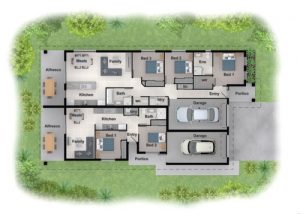 Where Should You Start?
Where Should You Start?



Could you or anyone recommend any good Granny Flat builders?
They are all charging similar prices so i want good service with a solid structured home
Thanks for the comment Sam. We don’t have anyone in particular that we recommend, but I would contact a few different builders in your area and ask to speak to some of their clients and/or see their finished work. Good luck!
Sam, you might find a builder recommendation on our forum site – https://www.propertyinvesting.com/topic/4407121-build-cost-for-granny-flat. @Brazen has some smart things to say about finding a builder in his post at the bottom. Hope this helps.
Hi Guys,
You mentioned me above so I’m chiming-in on the question of choosing a granny flat builder:
I agree that the (advertised) granny flat build prices tend to look very similar. This is a good thing in a competitive market. The problem is, how do you choose between them?
Firstly, I’d look very carefully at what their ‘standard inclusions’ are and I’d look closely at the quality of these inclusions. An example is that some builders do only ‘waffle-pod’ slab foundations whilst others do the much better ‘RC-Slab’ foundation system. Also watch for exclusions in the quote, such as ‘no excavated material & tipping fees are included’ or ‘connection of separate electricity meter not included’ and ‘site costs not included’. This is where there actually is a huge disparity between what’s advertised and what the final price is. So prices really aren’t as ‘similar’ as you might think. Some of the best ways to critically compare granny flat builders is to:
1. Check their finished work. When having a look, get up really close and discern the quality of the joinery work, the painting, the slab edges, the sealing work in bathrooms etc.
2. Talk to their previous customers. Admittedly this is not the best indicator, since they definitely wont send you to an unhappy customer, will they!
3. Read these (and other) property-investor forums and ask other people who have had a granny flat built. make sure it’s a recent comment since (I hear) some of the busiest builders’ work quality has suffered more recently.
4. Ask for photos of finished work and look at the company’s online portfolio.
5. Talk to the actual builder (not a salesperson!) and ask them some tough questions. Ask about ‘fixed pricing’ or ‘turn-key pricing’ and tell them what standard of inclusions you want.
6. Check the build quotation very, very carefully. If it’s very detailed and specific, that’s good and always check the exclusions.
Secondly, an often overlooked and key area of building is timeliness. It’s simply no good saving $10,000 on the build if it’s going to take an extra 6 months to do it. The lost rental earnings and disruption to the main dwelling’s tenants is a very critical part of the project’s success. A good builder is very sensitive to the needs of existing tenants with regard to keeping a clean site, timing the connection to all existing services and the overall conduct of his workers.
It’s also critically important to use a company which understand the legislation and all building codes. This is a key area where you can save a lot of money. I see a lot of inadequate plans done which cost extra time and money to rectify at construction. You definitely want the best design for your property. Granny flats aren’t built on vacant land, after all.
On timelines, I’ve heard stories of some of the better known companies taking up to 6 months to get an approval done. Not good. It should all be done (preparation, submission and granny flat approval) within 4 weeks, not twenty weeks!
At the end of the day, you need a builder who is accountable. By this I mean, if you have a concern or are unhappy about some part of the work, he/she will do exactly what’s needed, very quickly and to your complete satisfaction.
In my experience, builders will only try as hard as they are pushed. Unique to my granny flat building system is that IF you have a complaint regarding any of the work, he will fix it immediately. Why? Because if he doesn’t do the rectification works immediately, he won’t get anymore work in the future. So my guys are always eager to please the customer. This is a (very) critical point of difference, so compare carefully. In an industry fraught with complaints, it’s extremely valuable to have someone advocating for you.
Brazen.
Hi brazen
Just saw this post and really opened my eyes up a lot so thanks a lot!
Do you recommend any builders at all? even if they dont do grannys specifically.
Thanks Jason. I enjoyed that read. I agree with council approval for sure. Even if your neighbours don’t complain or council does not find out, when it comes time to selling this could reduce your net of buyers and most importantly your selling price. I didn’t know about the rules in each state so appreciate you went to length to get the basic rules.
Great point @MichaelGilbert on the resale issues of non-compliant granny flats. Thanks for the comment!
I own a dual dwelling Granny Flat. My 2 cents would be to highlight how powerful the cashflow can be with these properties. The property I own is originally constructed 1960s with the Granny Flat constructed early 1980s. They are very unrenovated and have high costs for maintenance due to things wearing out. I secured a 97% LVR loan and after all costs in the first year it was cashflow positive yielding 8.1%. The rents went up after a year and now yield 8.55%.
I think constructing new is the way to go and securing corner lots with a separate driveway where possible will net the best results.
Thanks for your comment @Clint. Just a quick question… How have you gone with council in the past with a separate cross-over on corner block granny flats? I’ve found that my local council is not very keen.
Always^^ and there are other hidden gems apart from corner lots. Wide blocks with enough space for a granny flat to the side, essentially creating the look and feel of an entirely new allotment is good. Another great one is lane-way accessed blocks but they’re admittedly rare as hen’s teeth.
A ‘classic block’ can work very well too, if a ‘battle-axe’ geometry can be created well. This is why it pays to get educated and to search out plots which have the right separation and privacy fundamentals. I write about it all the time in my blogs: http://www.grannyflatapprovals.com.au/
Brazen.
Hi Clint – when you say a ‘dual dwelling Granny Flat’ – are you talking about one granny flat with two occupants? I’m considering a granny flat in a place that is great for student accommodation, hence was thinking about a two bedroom granny flat rented out to two students…thoughts?
@Clint, maybe you can weigh in on this as well, but @Wayne, I can say that I’ve seen plenty of two bedroom granny flats around. In fact, I have a mate whose building one now. If you’re close to a uni in a granny flat friendly state, your idea could be a great way to boost your property’s cash flow.
* @Waynel
Do you need to own a land to build granny flat or can I get it in a package ? “ Australian food products
“